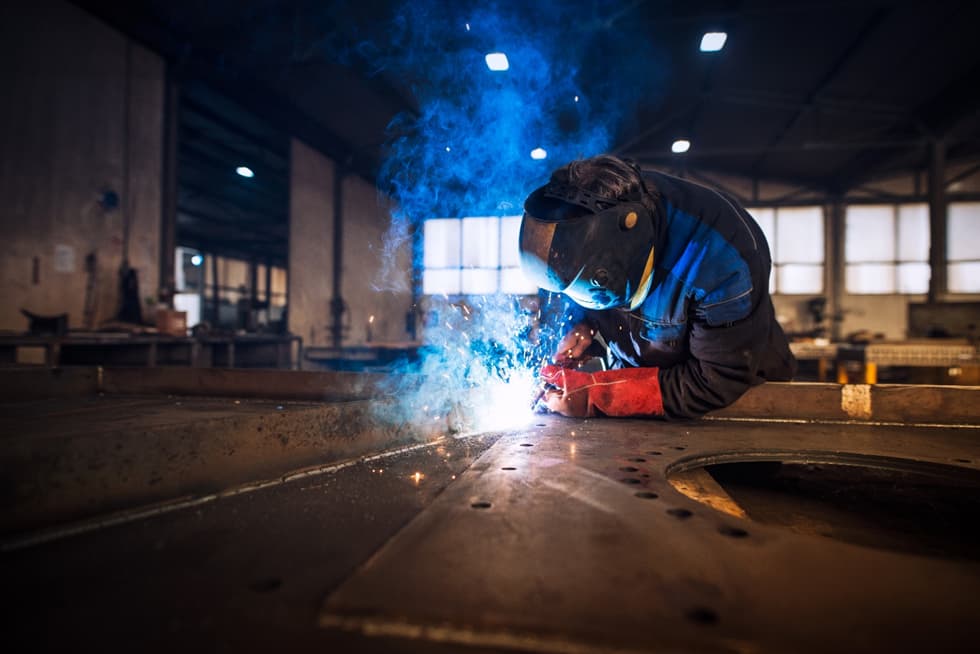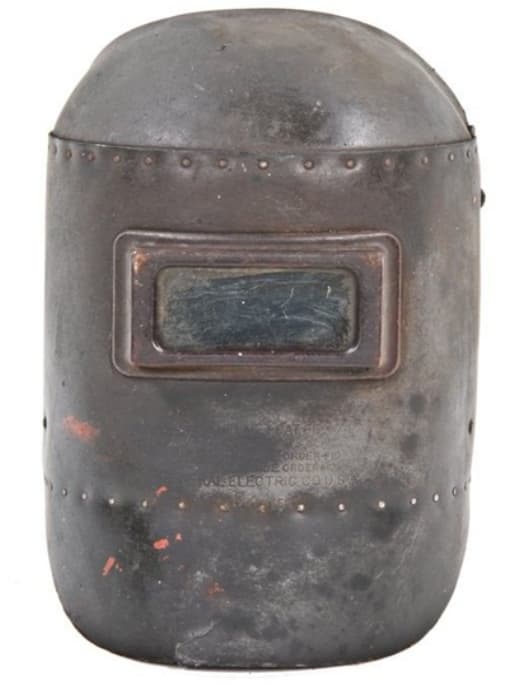What is Welding?

Industrial Welding is a creation cycle that joins materials, normally metals or thermoplastics, by utilizing high warmth to soften the parts together and permitting them to cool, causing combination. Welding is particular from lower temperature metal-joining strategies, for example, brazing and binding, which don’t soften the base metal. As well as dissolving the base metal, a filler material is regularly added to the joint to frame a pool of liquid material (the weld pool) that cools to shape a joint that, in light of industrial weld design (butt, full entrance, filet, and so forth), can be more grounded than the base material (parent metal). Pressing factor may likewise be utilized related to warm or without help from anyone else to create a weld. Welding additionally requires a type of shield to secure the filler metals or liquefied metals from being debased or oxidized.
Principles of Welding
Various fuel sources can be utilized for industrial welding, including a gas fire (synthetic), an electric bend (electrical), a laser, an electron shaft, grating, and ultrasound. While regularly a mechanical cycle, welding might be acted in various conditions, remembering for outside, submerged, and in space. Welding in industrial branches is a perilous endeavor and safeguards are needed to stay away from electric stun, sight injuries, inhale of noxious gases and vapor, and openness to extreme bright radiation.
Technical Development
Until the finish of the nineteenth century, the solitary welding measure before widespread industrial development, which metalworkers had utilized for centuries to join iron and steel by warming and pounding. Curve welding and oxy-fuel welding were among the primary cycles to grow late in the century, and electric opposition welding followed before long. Industrial welding innovation progressed rapidly during the mid-20th century as world encompassing wars drove the interest for solid and rapid joining techniques. Following the wars, a few present industrial welding strategies were created, including manual techniques like protected metal circular segment welding, presently perhaps the most mainstream industrial welding strategies, just as self-loader and programmed cycles, for example, gas metal curve welding, lowered bend welding, transition cored bend welding and electroslag welding.
History of Welding
Before 20th Century
The earliest instances of this come from the Bronze and Iron Ages in Europe and the Middle East. From that point forward, the Middle Ages acquired advances produce welding, in which metalworkers beat warmed metal more than once until holding happened. With the improvement of science in Renaissance, experts were talented all the while, and the business kept on developing during the accompanying centuries. In 1800, Sir Humphry Davy found the short-beat electrical curve and introduced his outcomes in 1801.In 1802, Russian researcher Vasily Petrov made the nonstop electric circular segment. Vital in this work was the portrayal of a steady circular segment release and the sign of its conceivable use for some applications, one being dissolving metals. World War I caused a significant flood in the utilization of welding, with the different military forces endeavoring to figure out which of the few new welding cycles would be best. Arc welding was first applied to airplane during the battle too, as some German plane fuselages were developed utilizing the process.
Pre-20thCentury
During the 1920s, significant advances were made in industrial welding innovation, remembering the presentation of programmed welding for 1920, in which anode wire was taken care of persistently. Protecting gas turned into a subject accepting a lot of consideration, as researchers endeavored to shield welds from the impacts of oxygen and nitrogen in the climate. Porosity and fragility were the essential issues, and the arrangements that created incorporated the utilization of industrial gases such as; hydrogen, argon, and helium as welding environments. During the next decade, further advances took into consideration the welding of responsive metals like aluminum and magnesium.
Mid-20th Century & Later

Other late advancements in welding incorporate the 1958 achievement of electron shaft welding, making profound and limited welding conceivable through the concentrated warmth source. Following the innovation of the laser in 1960, laser pillar welding appeared quite a few years after the fact, and has end up being particularly valuable in high velocity, mechanized welding. Attractive heartbeat welding (MPW) has been mechanically utilized since 1967. Erosion mix welding was designed in 1991 by Wayne Thomas at The Welding Institute (TWI, UK) and discovered great applications everywhere on the world. All of these four new cycles keep on being very costly because of the significant expense of the essential hardware, and this has restricted their applications.
Types of Welding
- Gas Tungsten Arc Welding (GTAW): A circular segment welding measure that utilizes a non-consumable tungsten cathode to deliver the weld. The weld region and terminal are shielded from oxidation or other barometrical pollution by a dormant protecting gas (argon or helium). A consistent flow welding power supply produces electrical energy, which is directed across the bend through a segment of profoundly ionized gas and metal fumes known as a plasma. GTAW is most ordinarily used to weld meager areas of tempered steel and non-ferrous metals like aluminum, magnesium, and copper composites.
- Electroslag Welding (ESW): An exceptionally profitable, single pass welding measure for thick materials in a vertical or near vertical position. An electric curve is at first struck by wire that is taken care of into the ideal weld area and afterward motion is added. Extra motion is added until the liquid slag, arriving at the tip of the cathode, douses the circular segment. The wire is then consistently taking care of through a consumable guide tube into the surfaces of the metal workpieces and the filler metal are then softened utilizing the electrical opposition of the liquid slag to cause blend.
- Flux-Cored Arc Welding (FCAW): A self-loader or programmed circular segment welding measure. FCAW requires a consistently taken care of consumable cylindrical anode containing a motion and a steady voltage or, less normally, a consistent current welding power supply. A remotely provided protecting gas is once in a while utilized, however regularly the actual transition is depended upon to create the vital assurance from the air, delivering both vaporous insurance and fluid slag ensuring the weld. The cycle is generally utilized in development in view of its high welding pace and transportability.
- Gas metal arc welding (GMAW): A welding cycle in which an electric circular segment structures between a consumable MIG wire anode and the workpiece metal(s), which warms the workpiece metal(s), making them intertwine. Alongside the wire terminal, a protecting gas takes care of through the welding firearm, which shields the interaction from barometrical pollution. A consistent voltage, direct current force source is most regularly utilized with GMAW, however steady current frameworks, too as substituting current, can be utilized.
Quality & Control of The Weld
Numerous particular elements impact the strength of welds and the material around them, including the welding strategy, the sum and grouping of energy input, the weldability of the base material, filler material, and motion material, the plan of the joint, and the connections between all these factors. To test the nature of a weld, either dangerous or nondestructive testing techniques are ordinarily used to check that welds are liberated from absconds, have adequate degrees of lingering stresses and contortion, and have worthy warmth influenced zone (HAZ) properties. Sorts of welding absconds incorporate breaks, twisting, gas considerations (porosity), non-metallic considerations, absence of combination, fragmented entrance, lamellar tearing, and undermining.
NDT of Welds
The regular welding absconds (absence of combination of the weld to the base metal, breaks or porosity inside the weld, and varieties in weld thickness) could make a construction break or a pipeline to burst. Welds might be tried utilizing NDT procedures, for example, modern radiography or mechanical CT examining utilizing X-beams or gamma beams, ultrasonic testing, fluid penetrant testing, magnetic particle examination or by means of eddy current. In an appropriate weld, these tests would demonstrate an absence of breaks in the radiograph, show clear entry of sound through the weld and back, or show a reasonable surface without penetrant caught in breaks. Welding methods may likewise be effectively observed with acoustic outflow strategies before creation to plan the best arrangement of boundaries to use to appropriately join two materials. For the situation of high pressure or wellbeing basic welds, weld checking will be utilized to affirm the predetermined welding boundaries (bend current, curve voltage, travel speed, heat input and so on) are being clung to those expressed in the welding methodology.
References
- Anders (2003). ”Tracking down the origin of arc plasma science-II. early continuous discharges”
- Cary, Howard B; Helzer, Scott C. (2005). Modern Welding Technology. Upper Saddle River, New Jersey: Pearson Education. ISBN 0-13-113029-3.
- A History of Welding. weldinghistory.org
- Sapp, Mark E. (February 22, 2008). “Welding Timeline 1900–1950”
- Weman, Klas (2003). Welding processes handbook. New York: CRC Press LLC. ISBN 978-0-8493-1773-6.
- Leroux, Bertrand (2015). “ELECTROSLAG WELDING (ESW): A New Option for Smelters to Weld Aluminum Bus Bars”. Light Metals 2015. The Minerals, Metals, and Materials Society. pp. 837–842
- Myers, T. (2021). Choosing a Shielding Gas for Flux-Cored Welding. Retrieved 10 March 2021, from http://lincolnelectric.com/en-us/support/process-and-theory/Pages/shielding-gas-for-flux-cored-welding.aspx?utm_referrer=https%3A%2F%2Fen.wikipedia.org%2F
- Blitz, Jack; G. Simpson (1991). Ultrasonic Methods of Non-Destructive Testing. Springer-Verlag New York, LLC.

